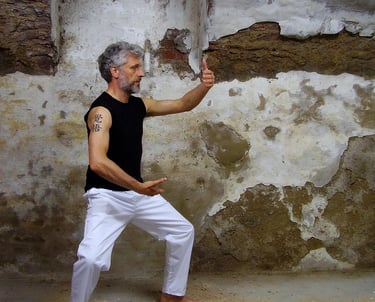Qigong
What is Qigong?
Qigong (氣功; pronounced chee gong) in Chinese means "work with the Qi" or "cultivate Qi". Qi is the energy that moves in and around us, giving us and all in nature health and vitality. When Qi becomes stuck, movement cannot occur and health declines. While any action done intentionally in order to move Qi can be Qigong, usually Qigong specifies prescriptive movements developed over thousands of years from ancient China.
Qigong consists of practices designed to cultivate and balance the body’s energy, or qi, to enhance overall health and well-being. It integrates both mental and physical elements, emphasizing the harmony of mind, breath, movement, and posture.
In most styles of qigong:
Breathing is slow, deep, and steady—often shifting between abdominal breathing and coordinated breathing with sound.
Movements are gentle, flowing, and promote relaxation.
Mental focus involves concentration and visualization.
Qigong can be active, involving coordinated movements, or passive, focusing on stillness, breath, and minimal movement. Both forms are seen in a class setting.




What are the Benefits of Qigong?
Research indicates that qigong can benefit the following:
Bone Health
Some studies show that post-menopausal women who do qigong may experience slowed bone loss or increased bone mineral density.Cardiovascular Effects
Those who do qigong regularly may see a lowered blood pressure, lowered heart resting heart rate, etc.
Physical Function & Mobility
For some, qigong has improved grip strength, walking speed, gait, and enhanced flexibility and functional movement in the elderly.
Falls Prevention & Balance
Regular practice of qigong may result in a reduced fall risk and better balance.
Quality of Life (QOL)
Qigong participants report a higher quality of life in the physical, psychological, and social domains.
Confidence
Some studies show increased confidence in working through stress, pain, and life or health challenges in those who practice qigong.
Symptom Reduction
Those who practice qigong may experience decreased pain and improvements in fatigue, disability, and sleep quality.
Psycho-emotional Benefits
They may report reduced anxiety, depression, mood disturbances, and stress.
Immune Function
Some studies have found increases in some immune cells, and changes in inflammatory markers in those who practice qigong.
More studies about qigong need to be performed, but the information collected is exciting and promising for those who practice qigong. To learn more about this, see the paper by Jehnke, et al referenced below.
What Style of Qigong Do You Practice?
Over 30,000 styles of qigong have been identified in mainland China, many of them modern takes on ancient practices. I have studied the Jinjing Gong (Tendon and Channel Qigong) style. This style has roots in the 2nd century from a monk named Bodhidarma. Later on, when the Manchus, a group from northern China invaded, in the 17th century, Buddhist and Daoist equivalent of nuns and monks took refuge on Mt Emei in China where they blended their martial arts and meditation practices into Jinjing qigong.
This style of qigong has been passed down in a lineage to Professor Wang Qingyu, the current lineage holder. I learned this style from his primary pupil and the next lineage holder Heiner Fruehauf.
For more information about this style, visit ClassicalChineseMedicine.org.
What is the Difference Between Qigong and Tai Chi?
Qigong and Tai Chi are both ancient Chinese practices that integrate movement, breath, and mindfulness to cultivate the body’s vital energy, or qi. Qigong is the broader, older system focused on energy cultivation for health, healing, and inner balance. It includes simple, repetitive movements, breathwork, and meditation that can be adapted for people of all ages and abilities. The goal of Qigong is to harmonize the mind, body, and spirit to support overall well-being and vitality.
Tai Chi, on the other hand, evolved from martial arts and incorporates the principles of Qigong into a flowing sequence of movements, known as a “form.” While Tai Chi is also practiced for relaxation and health, it emphasizes balance, coordination, and body awareness through continuous, circular motion. In essence, Qigong focuses more on internal energy cultivation, while Tai Chi expresses that cultivated energy through structured, mindful movement.


Sources
Jahnke R, Larkey L, Rogers C, Etnier J, Lin F. A comprehensive review of health benefits of qigong and tai chi. Am J Health Promot. 2010;24(6):e1-e25. doi:10.4278/ajhp.081013-LIT-248
Jinjing Qigong. ClassicalChineseMedicine.org. 2025. https://classicalchinesemedicine.org/education/jinjing-qigong/
Qigong: What You Need to Know. National Center for Complementary and Integrative Health. Updated February 2022. https://www.nccih.nih.gov/health/qigong-what-you-need-to-know
